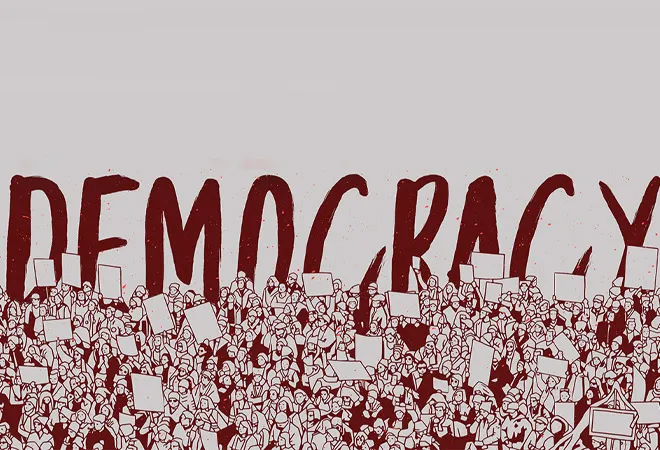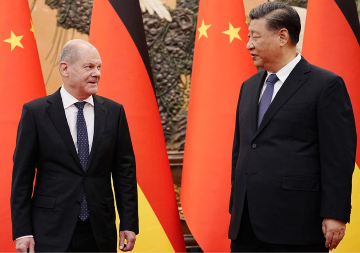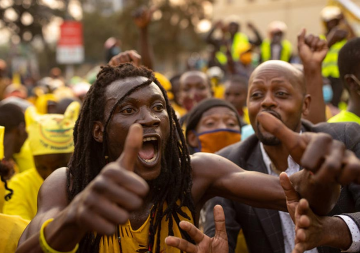 This article is a chapter in the journal — Raisina Files 2023.
This article is a chapter in the journal — Raisina Files 2023.
India is often described as the largest democracy in the world. The contours of that democracy, in its current form, are defined through the framework set by the Constitution. India is also one of the world’s oldest democracies, with its democratic traditions being rooted thousands of years ago,
<1> personified in the
sabhas and
samitis which had parallels in ancient Greece and Rome, too. The difference between these two entities, and their respective roles, evolved over time and, accordingly, the description varies across texts. Stated simply, however, the
samiti was like a general assembly, with representation from every household; the
sabha, meanwhile, was a smaller group akin to an executive committee, which also had judicial functions.
<2> The
sabha was a sub-set of the
samiti.
As modern states do, these ancient collective bodies took various decisions that involved participation, discussions, and trade-offs. These decisions lead to consequences and rare is the situation where a decision benefits everyone concerned. If situation X leads to an outcome that is better than situation Y for everyone, economists describe X as being ‘Pareto superior’ to Y. In most instances, however, Pareto superiority will be hard to come by. A decision leads to gains for some and losses for others. Those need to be traded off against each other and the overall gains (or losses) to society gauged. Therefore, in welfare economics, there is a body of theoretical work on compensation principles. Regardless of whether or not compensation can be implemented, there is a need for inter-personal (or inter-household) comparisons of gains or losses. This is virtually impossible, as one needs not only inter-personal comparisons but cardinal measurement as well. With ordinal measurement alone and a reasonable set of assumptions, one meets with problems discussed in social choice theory, spawned by Kenneth Arrow’s initial work.
<3>
Arrow’s initial possibility/impossibility theorem, defined by those reasonable sets of axioms, led to the existence of a dictator. Relaxation of the Arrow assumptions have led to hierarchies and oligarchies, without getting away from the basic problem—i.e., aggregating individual preferences into a preference by the collective body. That is what democracy is made of.
Some decisions are, by nature, more complicated than others. As collective bodies grow in size, decisions become more complicated. In contemporary jargon, a
sabha typified representative democracy, and a
samiti typified direct democracy. Except for purely local decisions, direct democracy rarely works. The collective body becomes too large for participation, discussion, and trade-offs. Modern States have thus moved away from direct democracy, even in the oft-cited Swiss canons. An extreme example of direct democracy is a referendum. But a referendum works when the choice is a binary of either accepting or rejecting a specific proposal; the Brexit referendum is a case in point. Rare is the collective decision, where pros and cons have to be discussed, that is of such a binary nature.
The
panchayati raj structure illustrates the difference. The nomenclature varies slightly across the country, but there is a three-tier structure, with a
Zila Parishad (district-level),
Panchayat Samiti (block-level) and a
Gram Panchayat (village-level). There is a completely separate argument about decision-making in India being too centralised, driven by pre-Independence colonial considerations and post-Independence planning priorities. A number of commissions and committees have flagged this and decentralisation of decision-making goes beyond fiscal devolution alone.
<4> It is a matter of decentralising from Union to States, and within States, down to local bodies.
<5> In India’s governance structure, there is the Union government, State governments, and local government. For every collective decision, there is an optimal level at which it ought to be taken—Union, State, and Local. Both above and below are sub-optimal and there is a convincing argument that the present structure is excessively centralised and sub-optimal.
<6> This still begs the question, though: Once the level at which a decision has to be taken is fixed, does the entire collective body assemble to take the decision, or is it an elected sub-set of the general body? At the level of the village, the Gram Sabha is the counterpart of the general body, but decisions will typically be taken by the elected Gram Panchayat, with subsequent information to the Gram Sabha.
In other words, democracy is per force representative, not direct. Taken somewhat out of context, this is nothing but Olson’s paradox.
<7> Large groups debate and dither. The United Nations (UN) General Assembly is an instance. Smaller groups are faster at decision-making. One reason is that efficient decision-making requires access to information, which cannot always be shared among larger groups. Would a referendum have been conceivable, for example, before either of the Pokhran tests in 1974 and 1998? Can one opt for a referendum when external and internal security are at stake? Etymologically, democracy means rule by the people. In complex societies, however, people do not rule directly but rather indirectly, through elected representatives.
Today it has become fashionable to rank countries across various indicators. Yet, these indicators often reflect value judgements. One classifies the indicators into heads, assigns weights to them, and obtains an index for each head. One then ascribes weights to the heads and obtains a value of the index for the country or the State concerned. They thus succeed in quantifying and measuring something that is often immeasurable and intangible, suggesting a robustness that does not exist. It becomes worse when objective data are not available. Regardless of the small size of the sample, one administers a perception-based questionnaire, asks respondents to score on a scale, adds those up, and obtains a score. This is done for many areas of public policy and the studies lack the transparency they themselves advocate. For democracy, the Economist Intelligence Unit (EIU) is the organisation that attempts the impossible. In its 2022 ranking, India is described as a ‘flawed democracy’, as is France.
<8> The United States is also described as a ‘flawed democracy’. Britain is described as a ‘full democracy’, although the recent workings of its democracy have revealed certain flaws, evident to anyone who is not an insider. Canada is a ‘full democracy’—a country where aboriginals (both men and women) did not have a right to vote until 1960. In India, following the promulgation of the Constitution, the first national elections were held in 1951-52, according all adults universal suffrage.
According to the EIU too, Australia is a ‘full democracy’. Yet, it was only in 1962 when indigenous Australians were allowed to vote. Another country classified as a ‘full democracy’ is Switzerland, where until 1971, women could not vote in national elections.
Regardless of what such surveys tell us, some points are obvious. First, traditions of democracy in India go back thousands of years. This is perhaps why, in contrast to some of its immediate neighbours, India has had uninterrupted democracy—barring the aberration of the Emergency period between June 1975 and March 1977. Second, notwithstanding the cynicism and non-participation of the urban elite, voter turnout in India is remarkably high, across all tiers of elections. For instance, as a cross-country comparison, in the 2019 Parliamentary elections, voter turnout in India was 67.4 percent. In Britain—classified by EIU as a ‘full democracy’—the voter turnout in the 2019 Parliamentary elections was 67.55 percent.
<9>
Third, every citizen and every voter in every country will have complaints about the working of the democratic process and its flaws in their own country. But that is not an argument against democracy. Indeed, democracy is often compared to oxygen: it is appreciated only when it is absent. As Winston Churchill said in an oft-quoted speech in the House of Commons in November 1947: “Many forms of Government have been tried, and will be tried in this world of sin and woe. No one pretends that democracy is perfect or all-wise. Indeed it has been said that democracy is the worst form of Government except for all those other forms that have been tried from time to time.”
<10>
The question is perhaps whether there is a correlation between democracy and development. To begin with, both terms—’democracy’ and ‘development’—are subject to various interpretations and there is enough literature that has examined the cross-country correlations between them.
At one level, one can argue that democracy is an end in itself; that it is a value one ought to strive for and not merely a means towards the end of development. Assuming there is a positive correlation, however, the correlation does not imply causation. The efficient functioning of democracy can lead to superior development outcomes; superior development outcomes can then lead to pressures for a better functioning democracy. Indeed, across the world, there has been a transition from lack of democracy to democracy.
The correlation between the two can also be spurious, in the sense of being caused by something extraneous. Much the same can be said of a term allied to democracy—that of ‘governance’. The World Bank’s set of governance indicators is based on six dimensions of voice and accountability, political stability and absence of violence/terrorism, government effectiveness, regulatory quality, rule of law, and control of corruption.
<11> Subject to what was said earlier about problems of cross-country comparisons, these dimensions do overlap with notions of democracy. Having said this, the cross-country empirical literature suggests that democracy is neither a necessary, nor a sufficient, condition for development. Nor is it the case that authoritarian regimes are conducive to development. Selective evidence from East Asia, with China and Vietnam included, or authoritarian oil-rich countries, do not establish the proposition.
Admittedly, democratic processes are slower, compared to authoritarian ones. This does not mean an authoritarian decision is superior. Democracy may slow down the taking of a good decision, from the welfare point of view, but it also provides checks and limits the chances of taking a bad decision. Therefore, expressions like ‘democracy tax’ look at only one side. There is also an element of a ‘democracy subsidy’.
In 2022, CUTS International examined the economic impact of select cases before the Supreme Court and the National Green Tribunal. Studying five cases, the study observed that between mid-2018 and mid-2021, around 75,000 persons in India were adversely impacted by those decisions, and some 16,000 workers lost their jobs. “The government did not receive revenues of around Rs. 8,000 crores, which, if were received and invested as capital expenditure, could have resulted in economic impact of more than Rs. 20,000 crores. The industry lost close to Rs. 15,000 crores in revenues, and workers lost around Rs. 500 crores of income, during the aforementioned period.”
<12> To be sure, one can sympathise with the arguments against judicial over-reach and the failure of judiciary to undertake proper judicial impact assessments.
<13>
In any democracy, what are the institutions that help build democracy? The Constitution describes three organs of State: legislature, executive, and judiciary, in both Union and State-level governments. Not all of these are elected. If the term ‘governance’ is used, as the World Bank’s indicators also illustrate,
governance must be broader than
government. Indeed, governance and democracy involve citizens, civil society and media too, and the Constitution’s Directive Principles of State Policy (Article 51A
<14>) also spell out the fundamental duties of citizens.
India has a thriving civil society and media that can rival those in so-called full democracies. Citizens are right to point a finger towards the imperfect functioning of the organs of State. These act as countervailing pressures. In particular, one should mention the Association for Democratic Reforms (ADR)
<15> and PRS Legislative Research.
<16> Such exercises improve transparency and accountability and their focus has been on the functioning of Parliament.
<17> There is relatively less scrutiny of executive and judiciary since they are not elected.
While the criticisms are in order, two points need to be mentioned. First, India, like many other countries, is an indirect and representative democracy. If one undermines faith in the institutions of governance, that undermines democracy, rather than strengthening it. Second, other than pointing a finger outwards, there is also the question of pointing inwards, at the extent to which individuals and enterprises help build democracy within their own ambits. After all, the Preamble to the Constitution begins with the words, “We the People”.
Indeed, we the People have built democracy in India for thousands of years.
Per se, that democracy is good and an end in itself. The pursuit of that democracy, and its perfection, is one pursuit of progress. The imperfections can be described as “bad”. But for most Indians, democracy is non-negotiable.
Endnotes
<1> Some of these strands are documented in
India: The Mother of Democracy, Raghuvendra Tanwar and Umesh Ashok Kadam, eds. (Indian Council of Historical Research, 2022).
<2> In
Rig Veda descriptions, there is no evidence of a gender bias.
<3> Kenneth J. Arrow,
Social Choice and Individual Values (Yale University Press, 1951).
<4> The First Administrative Reforms Commission (1966), Rajmannar Committee (1969), Sarkaria Commission (1983), the Second Administrative Reforms Commission (2005) and the Punchhi Commission (2007) are examples. Reflecting the mindset, the Punchhi Commission was called the Commission on Centre State Relations, suggesting a Centre at the core and States at the periphery. The Constitution uses the word ‘Union,’ not ‘Centre,’ though ‘Centre’ is routinely used.
<5> States have been reluctant to devolve downwards to Panchayati Raj institutions (PRIs) and urban local bodies (ULBs). There is also a broader issue of revamping the Seventh Schedule of the Constitution, based essentially on the Government of India Act of 1935.
<6> There is the tangential but related argument of state formation. States have not been constituted on governance principles—not at the time of the States Reorganization Commission or subsequently.
<7> In the sense that the size of the group matters, in reference to Mancur Olson,
The Logic of Collective Action (Harvard University Press, 1965). Olson was interested in the provision of public goods.
<8> “
A New Low for Global Democracy,”
The Economist, February 9, 2022.
<9> “
Voter Turnout by Country 2023,” World Population Review.
<10> “
The Worst Form of Government,” Winston Churchill. The expression “Indeed it has been said” indicates that Churchill was paraphrasing and quoting a prevalent thought rather than this being a Churchill original.
<11> “
Worldwide Governance Indicators,” World Bank.
<12> CUTS International,
Economic Impact of Select Decisions of the Supreme Court and National Green Tribunal of India, 2022. Of the five cases, three were by Supreme Court and two by the National Green Tribunal.
<13> This is equally true of legal impact assessments.
<14> Inserted in 1977.
<15> Association for Democratic Reforms.
<16> PRS Legislative Research.
<17> For example, productivity, electoral affidavits, criminalisation of politics, and politicisation of criminals.
The views expressed above belong to the author(s). ORF research and analyses now available on Telegram! Click here to access our curated content — blogs, longforms and interviews.



 This article is a chapter in the journal —
This article is a chapter in the journal —  PREV
PREV

